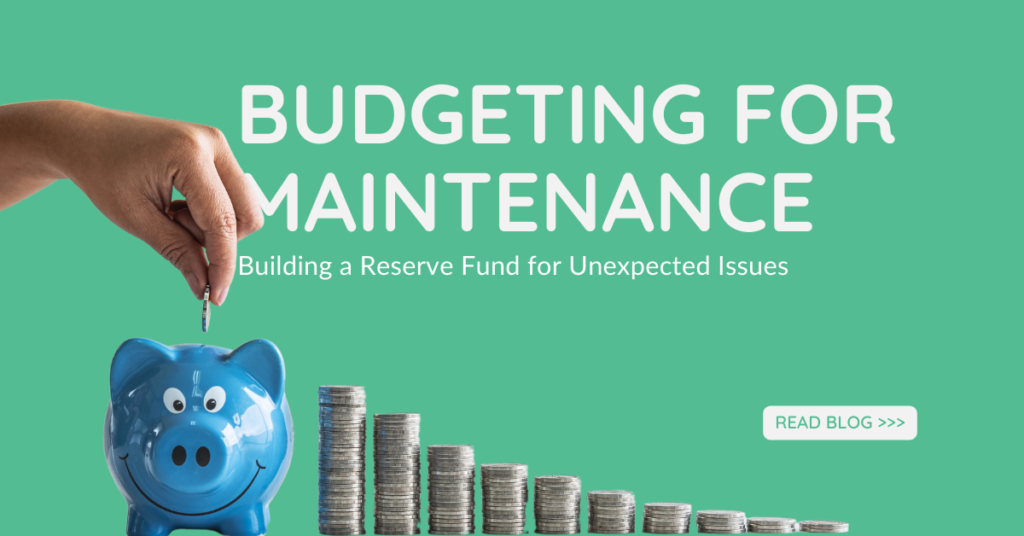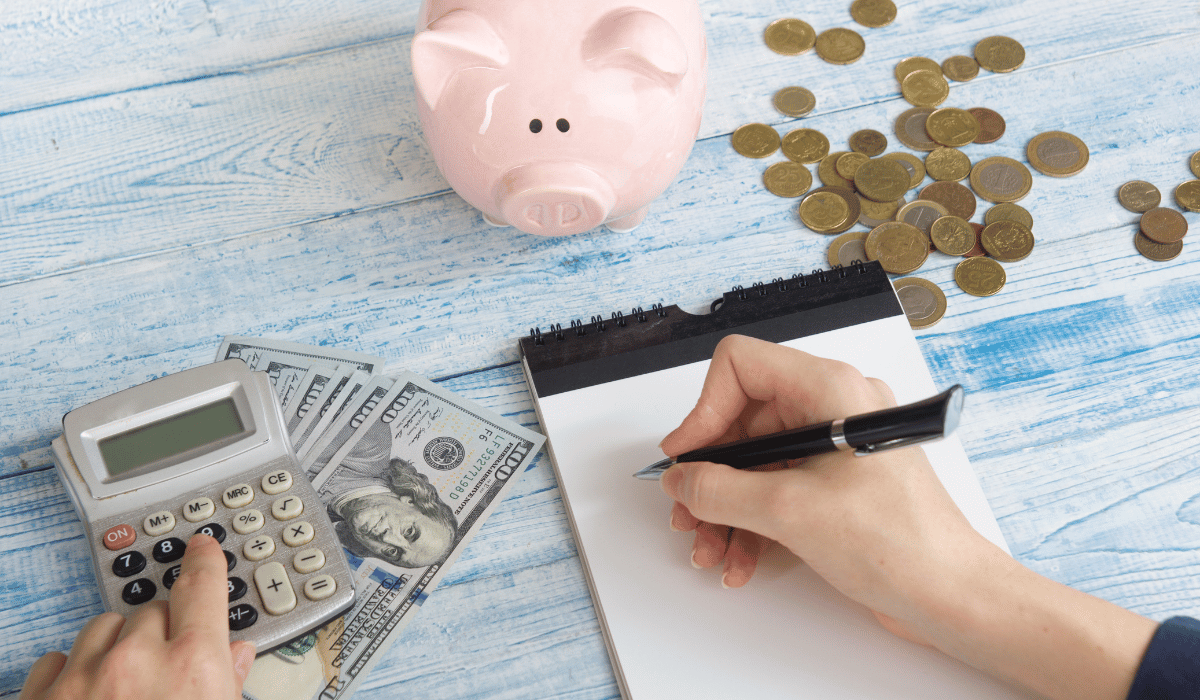Budgeting for Maintenance: Building a Reserve Fund for Unexpected Issues
Reading Time: 7 minutesOwning or managing a property requires constant vigilance. Despite preventive maintenance, unexpected issues can still arise. This can disrupt your budget and cause stress. A well-funded reserve fund acts as a financial safety net, allowing you to address these emergencies without scrambling. This article explores the importance of budgeting for maintenance and building a reserve…

Owning or managing a property requires constant vigilance. Despite preventive maintenance, unexpected issues can still arise. This can disrupt your budget and cause stress. A well-funded reserve fund acts as a financial safety net, allowing you to address these emergencies without scrambling.
This article explores the importance of budgeting for maintenance and building a reserve fund. We’ll guide you through estimating potential costs, setting a target amount, and managing your fund effectively.
Table of Contents
Understanding Maintenance Needs

A solid grasp of potential maintenance costs is vital for building a sufficient reserve fund. Here, we’ll delve deeper into the different categories of maintenance needs and explore strategies for estimating associated costs.
Categorize Maintenance Needs
There are three primary categories of maintenance to consider, each requiring a different budgeting approach:
- Preventive Maintenance: This proactive strategy involves regular upkeep to prevent future problems and extend the lifespan of your property’s systems. Examples include:
- Annual HVAC tune-ups and filter changes to maintain efficiency and air quality.
- Roof inspections to identify and address minor issues before they lead to leaks and major repairs.
- Gutter cleaning to prevent water damage to your foundation and siding.
- Fire extinguisher inspections to ensure proper functioning and safety compliance.
- Routine Maintenance: These are the everyday repairs that keep your property running smoothly and address minor issues before they escalate. Examples include:
- Appliance repairs for refrigerators, dishwashers, washing machines, and dryers.
- Plumbing fixes for leaky faucets, clogged drains, and malfunctioning toilets.
- Electrical repairs for faulty outlets, switches, and lighting fixtures.
- Painting touch-ups to address minor wall imperfections and maintain aesthetics.
- Capital Expenditures: These are larger, less frequent expenses for significant replacements or upgrades to major systems or building components. Examples include:
- Roof replacement due to age, storm damage, or leaks.
- HVAC system replacement when the existing unit reaches the end of its lifespan.
- Water heater replacement when the current unit fails or becomes inefficient.
- Major appliance upgrades such as replacing a cooktop or oven.
Estimate Maintenance Costs
Once you understand the categories of maintenance needs, you can start estimating the associated costs. Here are some key strategies:
- Research average costs for common repairs in your area. Many online resources and contractor websites provide cost estimates for various repairs. Consider factors like the size and complexity of your property when using these estimates.
- Consult with local contractors for more specific quotes on potential repairs. This can be particularly helpful for capital expenditures, as costs vary depending on materials, labor rates, and project scope.
- Utilize maintenance cost calculators: Several online tools and property management software programs offer calculators that can help you estimate annual maintenance costs based on property type, size, and location.
- Consider the age and condition of your property. Older buildings will likely require more frequent repairs and potentially more expensive replacements for aging systems.
- Factor in potential emergencies. Set aside a buffer in your budget for unforeseen circumstances such as a burst pipe, major storm damage, or a natural disaster. While you can’t predict these events, having some funds allocated can help you weather the financial storm.
By employing these strategies, you can develop a realistic understanding of your property’s potential maintenance costs and build a well-funded reserve to address them with confidence.
Building Your Reserve Fund

Having a clearly defined target amount for your reserve fund is crucial. This section will guide you through setting that goal and explore effective strategies for consistently funding it.
Set a Target Amount
The ideal amount for your reserve fund depends on several factors specific to your property. Here are some key considerations and general guidelines to help you determine the right target:
- Property Value: A common rule of thumb is to allocate 1-10% of your property’s current market value to the reserve fund. This provides a good starting point, but adjustments may be necessary based on other factors.
- Property Age and Complexity: Older properties with complex systems (e.g., large apartment buildings with elevators) will likely require more frequent and potentially more expensive repairs. You may need to target the higher end of the 1-10% range for such properties.
- Rental Properties: If you own a rental property, consider aiming for a reserve fund equal to 10-20% of your annual rental income. This buffer will help you cover unexpected repairs and maintenance needs during vacancy periods. Don’t forget to factor in historical vacancy rates when setting your target.
- Risk Tolerance: Some property owners prefer a more conservative approach and aim for a higher reserve balance to account for unforeseen circumstances. Consider your own comfort level when determining your target amount.
Fund Your Reserve Fund
Once you have a target amount in mind, it’s time to develop a solid plan for consistently building your reserve fund. Here are some effective strategies:
- Allocate a Portion of Your Monthly Budget: Treat your reserve fund like any other essential expense. Set aside a fixed monthly contribution from your rental income (for rentals) or property management budget.
- Automate Your Contributions: Setting up automatic transfers from your checking account to your reserve fund ensures consistent contributions and helps you avoid the temptation to spend that money elsewhere.
- Explore Additional Income Streams: If possible, consider generating additional income from your property to boost your reserve fund. Examples include renting out unused storage space, offering laundry facilities, or installing vending machines (if permitted by local regulations).
- Review and Adjust Regularly: As your property ages and your understanding of its needs evolves, revisit your target amount and funding strategy periodically. Adjust your monthly contributions or explore new income streams as needed to ensure your reserve remains adequately funded.
By following these steps, you can establish a clear path towards building a robust reserve fund that provides peace of mind and the financial resources to address any maintenance challenges your property may encounter.
Managing Your Reserve Fund
A dedicated account for your reserve fund is essential for responsible financial management. Here’s a closer look at choosing the right account and keeping meticulous records:
Choose a Dedicated Account
- High-Yield Savings Account: Select an account that offers a competitive interest rate to help your reserve fund grow over time. While the interest won’t significantly impact the total amount, every bit helps.
- Easy Access: While security is important, ensure you can access your funds readily when needed for repairs or emergencies. Avoid accounts with limitations on withdrawals.
- Separate Account: Maintain a separate account for your reserve fund entirely distinct from your operating accounts. This simplifies record-keeping and ensures the funds are clearly earmarked for maintenance needs.
Track and Replenish Funds
Transparency and accountability are key to managing your reserve fund effectively:
- Clear Records: Maintain meticulous records of all deposits and withdrawals associated with your reserve fund. Utilize a spreadsheet, accounting software, or dedicated record-keeping binder to track every transaction.
- Detailed Documentation: Include details like date, amount, purpose of transaction, and any relevant receipts or invoices for each deposit and withdrawal.
- Regular Reconciliation: Reconcile your reserve fund account regularly (e.g., monthly) to ensure your records match your bank statements.
- Replenishing Funds: After using funds for repairs or maintenance, prioritize replenishing your reserve to its target level. This ensures you’re prepared for future needs and don’t deplete your financial safety net.
Using Your Reserve Fund Effectively

A well-managed reserve fund empowers you to make informed decisions when unexpected maintenance issues arise. Here are some key strategies for using your reserve fund effectively:
Prioritize Maintenance Needs
Not all repairs are created equal. Here’s how to strategically utilize your reserve:
- Critical Repairs First: Address repairs that pose safety hazards or could lead to further damage if left neglected. Examples include roof leaks, electrical problems, or malfunctioning plumbing that could cause flooding.
- Preventative Maintenance: While not emergencies, consider using some reserve funds for preventative maintenance like major appliance tune-ups or HVAC cleaning. This can extend the lifespan of your systems and potentially prevent costly future repairs.
- Cost-Benefit Analysis: For non-critical repairs, weigh the cost against the potential consequences of delaying the repair. Sometimes, it may be more cost-effective to address the issue promptly
Get Quotes and Compare Costs
Don’t rush into repairs. Here’s how to ensure you get the best value for your reserve funds:
- Obtain Multiple Quotes: Get quotes from at least 3 qualified contractors before making a decision. This allows you to compare pricing, experience levels, and proposed solutions. Ask detailed questions about the scope of work, materials used, and warranties offered.
- Negotiate: Once you have quotes in hand, don’t be afraid to negotiate with contractors, especially for larger projects. Explain your budget constraints and see if they’re willing to work with you.
- Consider DIY (Do-It-Yourself) for Minor Repairs: For minor repairs with readily available instructions and materials, consider tackling them yourself to save on labor costs. However, only attempt DIY projects if you have the necessary skills and confidence to avoid causing further damage.
Document Repairs and Maintain Records
Keeping detailed records of all repairs completed using your reserve fund is crucial:
- Detailed Invoices: Request and retain detailed invoices from contractors for all completed repairs. These invoices should include the date, description of work performed, cost of labor and materials, and warranty information.
- Before & After Photos: Take photos of the damage before and after repairs are completed. This can be helpful documentation for insurance claims or future reference if similar issues arise.
- Organize Records: Maintain a system for organizing your repair records, whether it’s a dedicated folder, binder, or digital filing system.
Conclusion
Building a healthy reserve fund is an investment in your property’s long-term health and your financial security. By planning and budgeting effectively, you can address unexpected issues with confidence, avoiding financial strain and ensuring the smooth operation of your property.
Don’t let unexpected maintenance drain your resources! Green Ocean Property Management can help you develop a comprehensive maintenance plan and create a reserve strategy tailored to your specific property. Our team of experienced professionals can guide you through every step of the process, ensuring peace of mind and a financially secure future for your property.
Contact Green Ocean Property Management today for a free consultation!
Questions to Ask When Qualifying a Vendor
Reading Time: 3 minutes Property managers and landlords should know who to trust when it comes to property maintenance. Here are some questions to ask when qualifying a vendor. Who are vendors? Vendors are the people that go into your house and provide service. These can be plumbers, electricians, handymen, or appliance technicians. We need to make…
Lower your Liabilities with Proactive Maintenance Planning
Reading Time: 4 minutes As a landlord, planning ways on how to reduce your liability and preventing any accidents and injuries to your tenants are necessary. You need to learn how to lower your liabilities with Proactive Maintenance Planning. Here’s how. Think Proactive The best solution for every landlord is to have a proactive approach…
We make NO Security Deposits a Reality with Obligo
Reading Time: 3 minutes A security deposit is a one-time fee that is collected by most landlords. Usually, they charge up to three months’ worth of rent: that is the first month, last month, and security. Other terms for a security deposit are last month’s rent, advance deposit, or cleaning deposit. However you call it, security deposits are…








